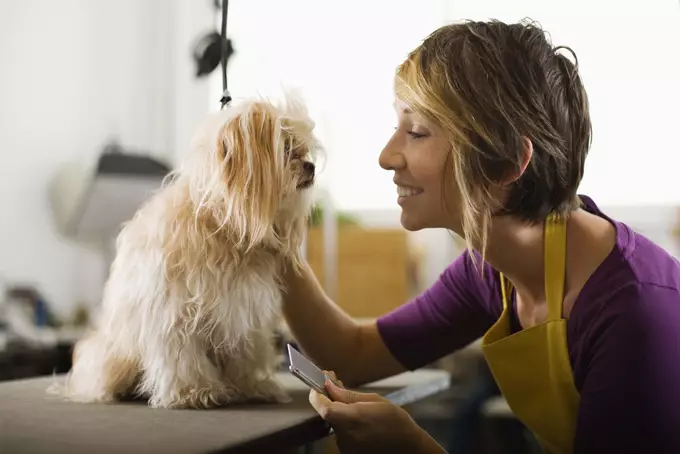Grooming is an essential aspect of responsible pet ownership that not only enhances the appearance of our canine companions but also promotes their health and well-being. While many dogs engage in self-grooming behaviors—like rubbing against furniture or licking their fur—they often require assistance from their owners to maintain a clean and healthy coat. Understanding how to effectively groom your dog can transform what may initially seem like a daunting task into a rewarding bonding experience.
Before diving into the grooming process, it’s crucial to choose the right time and approach. Dogs can be uncooperative or anxious during grooming, especially if they aren’t accustomed to being handled. An essential first step is to wait until your dog is calm—taking them for a walk or engaging in playtime beforehand can help facilitate this. Once they settle down, initiate the grooming session, but start short—aim for about 5 to 10 minutes for the initial sessions. Gradually extend the duration as your dog becomes more comfortable with the process.
During these early grooming sessions, it’s vital to ensure the experience remains positive. Use soft touches and gentle handling to familiarize your dog with being touched in various sensitive areas, such as the ears and paws. Praise your dog generously and consider offering treats throughout the process to help establish a positive association. The goal is to create a pleasant experience, rather than a stressful one.
Successful grooming also hinges on awareness of your dog’s specific coat type. Different breeds and coat textures necessitate varied grooming methods and schedules. For example, short-haired breeds like Chihuahuas or Beagles usually require less frequent grooming compared to long-haired breeds.
When caring for short coats, a simple weekly routine could include:
1. **Loosening debris**: Use a soft bristle brush to gently remove dirt and loose hairs.
2. **Removing dead hair**: Follow up with a firmer bristle brush.
3. **Finishing touches**: A chamois cloth can add an appealing shine.
Dogs with thicker or double coats, such as Huskies and Retrievers, often require a combing routine to manage potential matting. Utilizing a slicker brush first to tackle tangles is advisable, followed by using a bristle brush to clear away dead hair. Don’t forget to focus on the tail and other areas prone to matting.
Long-haired breeds, such as Cocker Spaniels and Afghan Hounds, can require daily grooming. Regularly brushing is essential to untangle knots and maintain your dog’s coat’s luster. Additionally, trimming may be necessary to keep their coats manageable and healthy.
Bathing is another vital component of grooming, and it should be done thoughtfully to avoid discomfort for your dog. It’s generally recommended to bathe dogs every three months, though those who spend more time outdoors may require more frequent cleaning. Choose mild, dog-friendly shampoos to prevent skin irritation.
To effectively bathe your dog, follow these steps:
1. **Preparation**: Brush your dog’s coat in advance to eliminate dead hair and mats.
2. **Safety first**: Place a non-slip mat in the tub to prevent sliding.
3. **Water temperature**: Use lukewarm water for comfort and fill the tub moderately.
4. **Gentle showering**: Use a handheld shower head to wet your dog, avoiding sensitive areas like the ears and eyes.
5. **Shampoo application**: Lather the shampoo thoroughly before rinsing well to leave no residue.
While bathing, take the time to inspect your dog’s ears, checking for dirt or odor. Cleaning them with a vet-approved solution can help prevent ear infections, especially in breeds susceptible to such issues.
Nail trimming can be one of the more challenging aspects of grooming, as many dogs are averse to having their paws handled. Preparing your dog by getting them accustomed to paw handling before setting out to trim their nails is imperative, including cleaning them of any debris.
When ready to trim nails, follow these key steps:
1. **Choose the right tool**: Use sharp, guillotine-style nail trimmers for clean cuts.
2. **Trimming technique**: Carefully snip the tip at a slight angle, being cautious to avoid cutting into the quick (the pink area within the nail).
3. **Handle mishaps**: If an accidental cut occurs, keep styptic powder on hand to manage any bleeding.
4. **Finishing touches**: An emery board can smooth jagged edges after cutting.
For breeds with loose skin, such as Shar-Peis, and long-eared breeds, additional grooming measures are essential. Keep skin folds clean and dry, and check ears weekly to prevent wax buildup. Regular grooming doesn’t just promote cleanliness; it nurtures the bond between you and your furry friend, fostering trust and comfort that lead to more enjoyable sessions in the future.
Grooming is more than just a chore; it’s a vital part of dog care that reinforces the bond between pet and owner. With the right techniques and a compassionate approach, grooming can become a rewarding experience for both you and your furry companion. By understanding your dog’s grooming needs and incorporating positive reinforcement, you can ensure that every session is not only productive but also enjoyable. Your dog will not only look their best but will feel great too—making grooming a worthwhile investment of your time.

